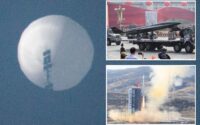Astronomers hopeful of receiving an alien reply today after beaming message out into space 40 years ago
Astronomers are anxiously waiting to see if today will be the day humanity finds out if we have any intelligent neighbors in the cosmos — four decades after sending a message out into the universe.
The message contained 13 drawings depicting the history of life on Earth through the stages of evolution.
It was then transcribed into radio waves and beamed out into space by astronomers at Stanford University on Aug. 15, 1983, with the intention of making contact with intelligent alien life in the future.
Today, scientists in Japan will start scanning the sky for a reply, according to the Japanese newspaper Asahi Shimbun.
Altair — the 12th brightest star in the night sky, found in the Aquila constellation 16.7 light-years away from our pale blue dot — could be the first area of the observable universe to send back a responding message as early as 9 a.m. (EST) today, the outlet reported.
“A large number of exoplanets have been detected since the 1990s,” said Shinya Narusawa, a professor at the University of Hyogo in Japan, who is now leading the team tasked with searching the sky for any unusual radio signals, told the outlet.

Narusawa, 58, believes intelligent life lingers somewhere in the universe, and it’s possible a planet in Altair’s solar system could be harboring intelligent extraterrestrial life.
“Altair may have a planet whose environment can sustain life,” he told the outlet.
An exoplanet is any planet outside our solar system orbiting a star — though there are free-floating exoplanets called “rogue planets” that are untethered in space, according to NASA.

Using antennas from the Japan Aerospace Exploration Agency (JAXA) in central Japan, Narusawa and his team will spend hours searching the sky for any sign of a responding message.
Also included in the 40-year-old message is knowledge of our solar system and an explanation of DNA, according to the outlet.
Though the astronomers are committed to beginning their search, the team symbolically picked the date to coincide with the lunar calendar’s date of Tanabata.

In Japan, Tanabata — also referred to as the “star festival” — is celebrated on the seventh day of the seventh month of each year, but for the lunar calendar, Tanabata falls on Aug. 22, which prompted Narusawa and his team to pick today as the kick-off to begin the search, according to the outlet.
Even if today is not the day humans receive a glimmer of hope of not being alone in the universe, that does not necessarily mean the mission has failed.
It’s believed that the “Hello, is anybody there?” message — sent out in the 1980s by professors Masaki Morimoto and Hisashi Hirabayashi — has had enough time to reach planets circling Altair and if there is intelligent life living on that planet, they may have responded already.


Scientists are prepared to wait longer if no answers are found today, and the mission is far from being considered a failure if no replies are detected during the initial search.
Morimoto — described as “an inspiration for the younger generations entering the newly born radio astronomy community in Japan” by the International Astronomical Union — died in 2010. He was 78.
Hirabayashi, 80, has since published several books on the possibilities of intelligent life in the universe and is currently an emeritus professor with JAXA.
Last month, A former Air Force officer and intelligence official told Congress he believes the US government is hiding captured UFOs — and claimed he could not reveal whether anyone was murdered to keep the secret contained.
“Based on interviewing over 40 witnesses over four years and where, I know the exact locations [the UFOs are kept],” former national reconnaissance officer representative for the Pentagon’s Unidentified Anomalous Phenomena Task Force, David Grusch said.


